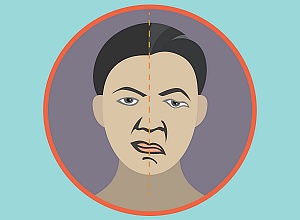The Pfizer/BioNTech vaccine has not been linked with a higher risk for the facial nerve paralysis known as Bell's palsy, but COVID-19 itself does increase the risk, suggest two separate studies published on JAMA Otolaryngology-Head and Neck Surgery.
The one study involved 110 people in Israel who received the Pfizer vaccine, including 37 in whom the characteristic facial droop developed on average nine days after the first dose or 14 days after the second. After accounting for underlying risk factors for Bell's palsy, the researchers concluded the vaccine itself did not increase the risk. Furthermore, they found, rates of Bell's palsy had not gone up during the vaccine rollout.
In the second study, researchers compared Bell's palsy rates among roughly 348,000 patients with COVID-19 and roughly 63,500 people who had been vaccinated against the coronavirus. The Bell's palsy risk was nearly seven times higher in those with COVID-19, they found. “Our data suggest that rates of facial nerve palsy are higher in patients who are positive for COVID-19, and this incidence exceeds the reported incidence of Bell's palsy with the COVID-19 vaccine,” said Dr Akina Tamaki of University Hospitals Cleveland Medical Center, who coauthored that study. “Taken together, it supports that the vaccine is safe from a facial nerve paralysis standpoint.”
First Study details
Association of COVID-19 Vaccination and Facial Nerve Palsy: A Case-Control Study
Authors: Asaf Shemer, Eran Pras, Adi Einan-Lifshitz, Biana Dubinsky-Pertzov, Idan Hecht
Published in JAMA Otolaryngol Head Neck Surgery on 24 June 2021
Abstract
Peripheral facial nerve (Bell) palsy has been reported and widely suggested as a possible adverse effect of the BNT162b2 (Pfizer-BioNTech) COVID-19 vaccine. Israel is currently the leading country in vaccination rates per capita, exclusively using the BNT162b2 vaccine, and all residents of Israel are obligatory members of a national digital health registry system. These factors enable early analysis of adverse events.
Objective
To examine whether the BNT162b2 vaccine is associated with an increased risk of acute-onset peripheral facial nerve palsy.
Method
This case-control study was performed from January 1 to February 28, 2021, at the emergency department of a tertiary referral center in central Israel. Patients admitted for facial nerve palsy were matched by age, sex, and date of admission with control patients admitted for other reasons.
Main outcomes and measures
Adjusted odds ratio for recent exposure to the BNT162b2 vaccine among patients with acute-onset peripheral facial nerve palsy. The proportion of patients with Bell palsy exposed to the BNT162b2 vaccine was compared between groups, and raw and adjusted odds ratios for exposure to the vaccine were calculated. A secondary comparison with the overall number of patients with facial nerve palsy in preceding years was performed.
Results
Thirty-seven patients were admitted for facial nerve palsy during the study period, 22 (59.5%) of whom were male, and their mean (SD) age was 50.9 (20.2) years. Among recently vaccinated patients (21 [56.7%]), the mean (SD) time from vaccination to occurrence of palsy was 9.3 (4.2 [range, 3-14]) days from the first dose and 14.0 (12.6 [range, 1-23]) days from the second dose. Among 74 matched controls (2:1 ratio) with identical age, sex, and admittance date, a similar proportion were vaccinated recently (44 [59.5%]). The adjusted odds ratio for exposure was 0.84 (95% CI, 0.37-1.90; P = .67). Furthermore, analysis of the number of admissions for facial nerve palsy during the same period in preceding years (2015-2020) revealed a relatively stable trend (mean [SD], 26.8 [5.8]; median, 27.5 [range, 17-35]).
Conclusions and relevance
In this case-control study, no association between acute facial nerve palsy and recent vaccination with the BNT162b2 vaccine was observed. In addition, despite rapid and extensive vaccination of the population, a similar volume of admissions for facial nerve palsy was seen compared with the same period in preceding years.
Full report in JAMA Otolaryngol Head Neck Surgery (Open access)
See also from the MedicalBrief archives:
Encouraging safety results from Sisonke trial of J&J vaccine in SA

